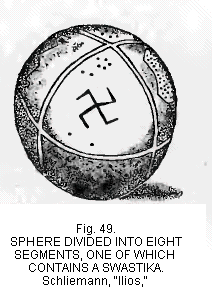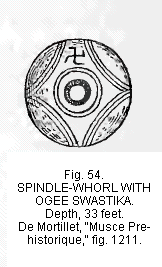

The Swastika
Dispersion of the Swastika
 right, but with uncertain lines and at indefinite angles. In one of them
the main line forming the cross is curved toward the central hole; in
another, the ends are both bent in the same direction–that is, pointing
to the periphery of the whorl. Fig. 49 shows a sphere or globe (see figs.
75,88) divided by longitudinal
lines into four segments, which are again divided by an equatorial line.
These segments contain marks or dots and circles, while one segment contains
a normal Swastika turned to the left. This terr-cotta ball has figured
in a peculiar degree in the symbolic representation of the Swastika. Greg
says of it: (1)
right, but with uncertain lines and at indefinite angles. In one of them
the main line forming the cross is curved toward the central hole; in
another, the ends are both bent in the same direction–that is, pointing
to the periphery of the whorl. Fig. 49 shows a sphere or globe (see figs.
75,88) divided by longitudinal
lines into four segments, which are again divided by an equatorial line.
These segments contain marks or dots and circles, while one segment contains
a normal Swastika turned to the left. This terr-cotta ball has figured
in a peculiar degree in the symbolic representation of the Swastika. Greg
says of it: (1)We see on one hemisphere the
Fig. 50 represents one of the biconical spindle-whorls with various decorations on the two sides, longitudinal lines interspersed with dots, arcs of concentric circles arranged in three parallels, etc.
 On one of these sides is a normal Swastika, the arms crossing at right
angles, the ends bent at right angles to the left. The specimen shown
in fig. 51 contains four perfect Swastikas and two inchoate and uncertain.
Both of the latter have been damaged by breaking the surface. The four
Swastikas all have their arms bent to the right; some are greater than
at right angles, and one arm is curved. Several ends are tapered to a
point. Fig. 52 shows a whorl
of biconical form. It contains two Swastikas, the main arms of which are
ogee forms, crossing each other at the center at nearly right angles,
the ogee ends curving to the right. In fig.
53 the entire field of the upper surface is filled with, or occupied
by, a Greek cross, in the center of which is the central hole of the whorl,
while on each of the four arms is represented a Swastika, the main arms
all crossing at right angles, the ends all bent to the right at slightly
obtuse angle. Each of these bent ends tapers to a point, some with slight
curves and a small flourish. (See figs.
33 and 34 for reference
to this flourish.) The specimen shown in fig. 54
On one of these sides is a normal Swastika, the arms crossing at right
angles, the ends bent at right angles to the left. The specimen shown
in fig. 51 contains four perfect Swastikas and two inchoate and uncertain.
Both of the latter have been damaged by breaking the surface. The four
Swastikas all have their arms bent to the right; some are greater than
at right angles, and one arm is curved. Several ends are tapered to a
point. Fig. 52 shows a whorl
of biconical form. It contains two Swastikas, the main arms of which are
ogee forms, crossing each other at the center at nearly right angles,
the ogee ends curving to the right. In fig.
53 the entire field of the upper surface is filled with, or occupied
by, a Greek cross, in the center of which is the central hole of the whorl,
while on each of the four arms is represented a Swastika, the main arms
all crossing at right angles, the ends all bent to the right at slightly
obtuse angle. Each of these bent ends tapers to a point, some with slight
curves and a small flourish. (See figs.
33 and 34 for reference
to this flourish.) The specimen shown in fig. 54 has a center field in its upper part, of which the decoration consists
of incised parallel lines forming segments of circles, repeated in each
one of the four quarters of the field. The center hole is surrounded by
two concentric rings of incised lines. In one of these spaces is a single
Swastika; its main arms crossing at right angles, two of its ends bent
to the left at right angles, the other two in the same direction and curved.
has a center field in its upper part, of which the decoration consists
of incised parallel lines forming segments of circles, repeated in each
one of the four quarters of the field. The center hole is surrounded by
two concentric rings of incised lines. In one of these spaces is a single
Swastika; its main arms crossing at right angles, two of its ends bent
to the left at right angles, the other two in the same direction and curved.The Fourth City (13.2 to 17.6 feet deep).– Schliemann says: (2)
We find among the successors of the burnt city the same triangular idols; the same primitive bronze battle-axes; the same terra-cotta vases, with or without tripod feet; the same double-handled goblets; the same battle-axes of jade, porphyry, and diorite; the same rude stone hammers, and saddle querns of trachyte * * * The number of rude stone hammers and polished stone axes are fully thrice as large as in the third city, while the masses of shells and cockles
ENDNOTES:
1. Archaeologia, xlviii, pt. 2, p. 322. [Back]
2, “Ilios,” pp. 518,571. [Back]
<< Previous Page Next Page >>
© 2004-2007 Northvegr.
Most of the material on this site is in the public domain. However, many people have worked very hard to bring these texts to you so if you do use the work, we would appreciate it if you could give credit to both the Northvegr site and to the individuals who worked to bring you these texts. A small number of texts are copyrighted and cannot be used without the author's permission. Any text that is copyrighted will have a clear notation of such on the main index page for that text. Inquiries can be sent to info@northvegr.org. Northvegr™ and the Northvegr symbol are trademarks and service marks of the Northvegr Foundation.

|